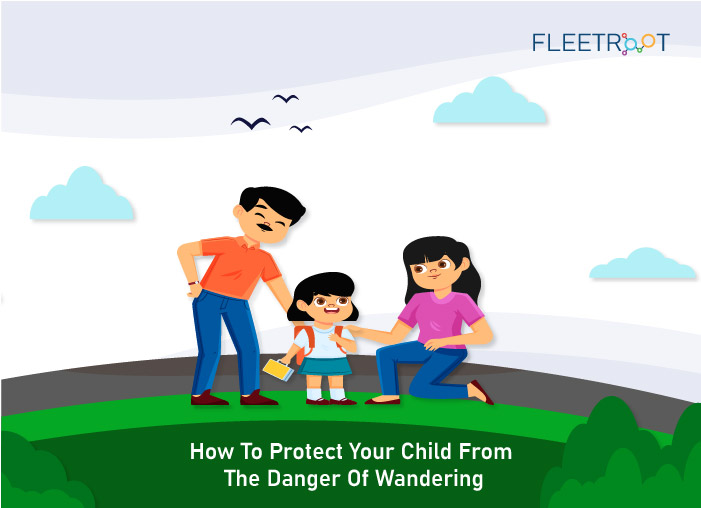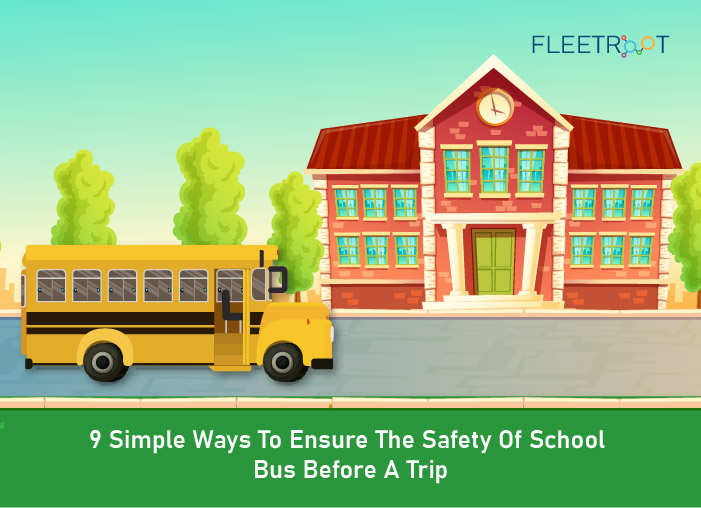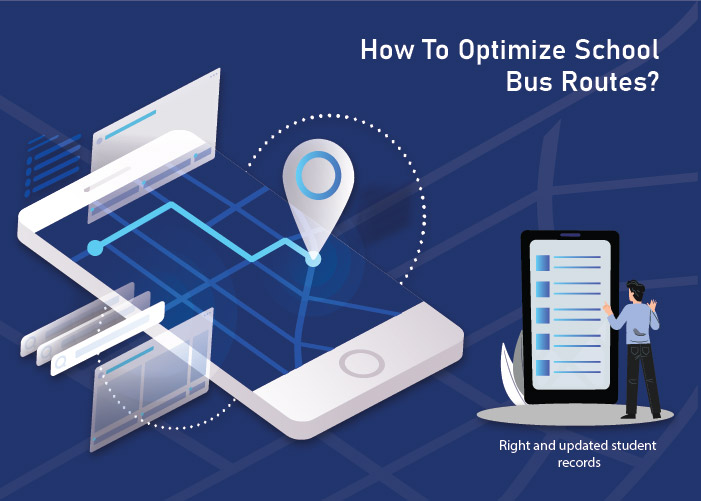A little child wandering a few feet away from his parents in a public place may go unnoticed by most, but parents know the acute stress and panic they experience when their child goes out of their sight, even for a few minutes.
The fact is, child wandering is a real and serious issue worldwide: while it is a common occurrence amongst all toddlers, research has shown that children with ASD (Autistic Spectrum Disorder) are four times more prone to wandering away from a safe environment than others, and they wander even as they get older.
This poses a grave threat to their safety and well-being – putting them at high risk of drowning, getting hit by a vehicle, dehydration, kidnapping, assault etc.
Why Children Wander
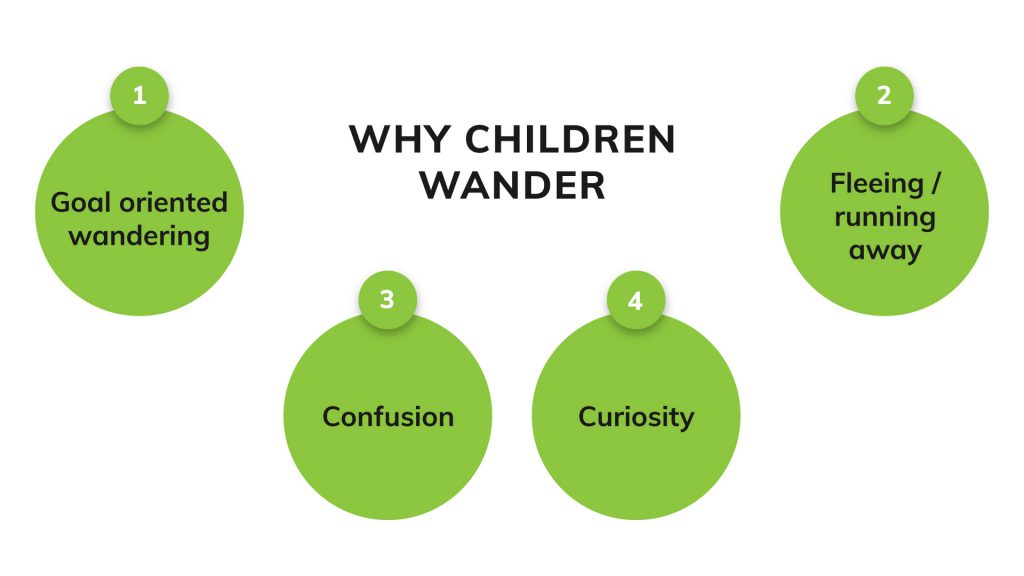
Goal oriented wandering: A child may walk away for a specific purpose: e.g., to look for food, or a toy, etc.
Fleeing / running away: Autistic children may get overwhelmed by bright lights or a social setting with unknown people around them, and they want to run away from the unsettling situation.
Confusion: Children may suddenly feel confused or wake up feeling disoriented in the night, which could lead to wandering.
Curiosity: Children have a natural urge to explore, and autistic children tend to wander out of boredom or curiosity. They are attracted to water bodies since water has a calming influence on them. That is why research has shown that 3 out of 4 deaths due to child wandering take place on account of drowning.
What You Can Do to Prevent Your Child from Wandering
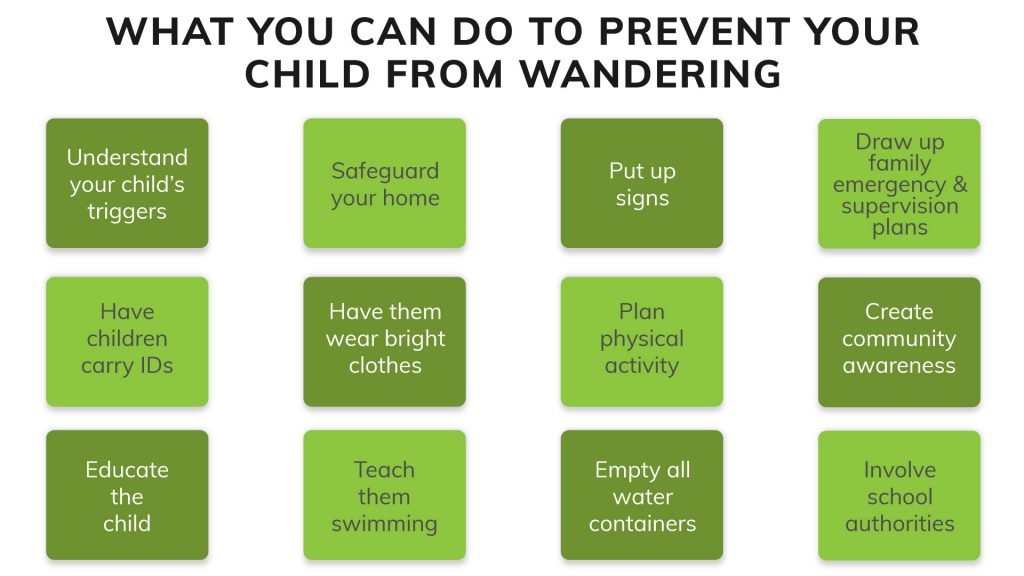
Understand your child’s triggers:
Learn to recognize the triggers that upset your child or make them want to wander, and work towards controlling his environment accordingly.
E.g., Using noise cancelling headphones might help the child to cope in a noisy environment. If the child likes to look for certain objects, place a few of them just outside the home, so that they could hold his attention and stall the wandering.
Safeguard your home:
Put locks on your doors and windows sufficiently high up so they are out of reach. Use bars on the windows. If possible, use home security alarm systems to alert you if the child tries to leave. You could even keep a trained dog to help keep your child safe.
Put up signs:
Teach your child to recognize common signs like Stop, Do Not Enter, Bathroom etc., and put them up on the doors, so that the child does not accidentally step outside the house.
Draw up family emergency and supervision plans:
Keep a checklist ready of all the places the child likes to go to- ponds, lakes, gardens, play grounds etc., in the vicinity. Also, when the family goes out, have a tag system in place so that every family member takes turns to watch over the child.
Have children carry IDs:
Have the child wear a bracelet that has all the contact information on it. You could also use a temporary tattoo for the same purpose.
Have them wear bright clothes:
While going out, always dress the child in bright colored clothes. These will help you to easily locate him in a crowd or from a distance.
Plan physical activity:
Take the child for a walk, prevent daytime napping, or have him do some physical activity, so that he gets a restful sleep and does not wander off into the night.
Create community awareness:
Let the neighbors know that an autistic child lives in their area, and what to do if they see him unattended outside the home.
Educate the child:
Use stories to teach the child some self-calming techniques in a stressful situation, and verbalize what he is feeling through words. Teach him how to identify himself in front of law enforcement.
Teach them swimming:
Find out swimming classes for special children in your vicinity and get your child to learn swimming. Make sure that the child also learns to swim in wet clothes and shoes.
Empty all water containers:
Empty all baby pools, buckets, pails, water bowls and cans around the house that may have water in them, to keep the child away from water bodies of any kind, while he is unattended.
Use fencing:
If you can afford it, secure the boundaries of your home with at least a four feet high fencing with self-closing and self-latching gates. This will protect your child and also offer him a bit of freedom and fresh air.
Involve school authorities:
It is important for parents to inspect the school premises and facilities to ensure that they are safe for the child and in accordance with his special needs.
Many schools do not think it necessary to inform parents if their child was found wandering from the school, hence parents must regularly meet and check with the staff and authorities and make sure they are promptly notified of such happenings.
If the child needs special education services / attention in the school, or assistance to and from classes, this must be documented in the child’s IEP (Individualized Education Program).
Talk to local first responders:
Parents must inform local law enforcement about their child, and hand over as much detail as possible, including his picture, his habits and fascinations, places that he likes to frequent etc. so that they can take quick action, should a situation arise.
Learn from others:
It is important to also be in touch with parents of other special children and learn from each other’s experiences on what worked in keeping their child safe, and what could have been changed or avoided.
Use personal locator devices:
There are a host of locator devices in the market that you could use to keep a track of your child, ranging from smart watches to GPS trackers to radio frequency wristbands/anklets.
However, you need to carefully assess them to check on critical features such as wearability, battery life, geofencing, accuracy and water proof functioning.
When it comes to protecting an autistic child on the move, a GPS device with low accuracy is as pointless as one with a short battery life or one that does not have water proof functioning.
Keep abreast of the latest technologies:
New technologies that can more effectively prevent child wandering, are the need of the hour. Nowadays, the latest GPS based school bus trackers have added an additional layer of security for children by incorporating RFID technology.
This involves the use of RFID chips, uniquely coded for every child, embedded into every child’s ID badge. RFID scanners can then track children not only during the school commute, but also in various places inside the school premises, giving parents a much better visibility of their child’s whereabouts and instantly alerting them if their child wanders within or outside the school premises.
Conclusion
Autistic children are not only more prone to wandering, they are also much more vulnerable than other children, in the face of various dangers. And as these children grow, their interests, environments and motor skills will change and so will their ability to turn door knobs and open door latches.
As such, parents can never be too careful when it comes to their safety. However, a collaborative effort by autism safety organizations, schools, communities and government bodies can go a long way in effectively tackling this issue.
What do you think? Let us know your views by commenting below.
